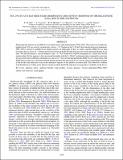NGC 2992 IN AN X-RAY HIGH STATE OBSERVED BY XMM-NEWTON : RESPONSE OF THE RELATIVISTIC Fe Kα LINE TO THE CONTINUUM
Author(s)
Shu, X. W.; Yaqoob, T.; Braito, V.; Wang, J. X.; Zheng, W.; Murphy, Kendrah Dawn; ... Show more Show less
DownloadShu-2010-NGC 2992 IN AN X-RAY.pdf (426.0Kb)
PUBLISHER_POLICY
Publisher Policy
Article is made available in accordance with the publisher's policy and may be subject to US copyright law. Please refer to the publisher's site for terms of use.
Terms of use
Metadata
Show full item recordAbstract
We present the analysis of an XMM-Newton observation of the Seyfert galaxy NGC 2992. The source was found in its highest level of X-ray activity yet detected, a factor ~23.5 higher in the 2-10 keV flux than the historical minimum. NGC 2992 is known to exhibit X-ray flaring activity on timescales of days to weeks, and the XMM-Newton data provide at least a factor of ~3 better spectral resolution in the Fe K band than any previously measured flaring X-ray state. We find that there is a broad feature in the ~5-7 keV band that could be interpreted as a relativistic Fe Kα emission line. Its flux appears to have increased in tandem with the 2-10 keV continuum when compared to a previous Suzaku observation when the continuum was a factor of ~8 lower than that during the XMM-Newton observation. The XMM-Newton data are consistent with the general picture that increased X-ray activity and corresponding changes in the Fe Kα line emission occur in the innermost regions of the putative accretion disk. This behavior contrasts with the behavior of other active galactic nuclei in which the Fe Kα line does not respond to variability in the X-ray.
Date issued
2010-04Department
MIT Kavli Institute for Astrophysics and Space ResearchJournal
Astrophysical Journal
Publisher
IOP Publishing
Citation
Shu, X. W., T. Yaqoob, K. D. Murphy, V. Braito, J. X. Wang, and W. Zheng. “ NGC 2992 IN AN X-RAY HIGH STATE OBSERVED BY XMM-NEWTON : RESPONSE OF THE RELATIVISTIC Fe Kα LINE TO THE CONTINUUM .” The Astrophysical Journal 713, no. 2 (April 1, 2010): 1256–1265. © 2010 The American Astronomical Society
Version: Final published version
ISSN
0004-637X
1538-4357